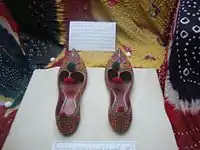Multani Khussa
Khussa (Urdu: کُھسّہ ), is a style of South Asian handcrafted footwear produced in Punjab Pakistan.

Khussa are made by artisans mostly using vegetable-tanned leather. The uppers are made of one piece of leather or textile embroidered and embellished with brass nails, cowry shells, mirrors, bells and ceramic beads. Even the bonding from the upper to the sole is done by cotton thread that is not only eco-friendly but also enmeshes the leather fibers with great strength. Some product range also uses bright and ornate threads.[1]
In ancient times these were worn by multitude and royalty. As it evolved through the centuries and is being produced by individual artisans, products vary in designs and colours. It encapsules cultural diversity, local ethos and ethnicity.
The ethnicity of the traditional skills accentuate into poetry when intermingled with the contemporary colours and designs. Appliqué in the form of differently designed figures are cut out of leather and sewn on the vamp manually. The design would dictate the nature, colour and shape of the appliqué. It could range from an intricate appliqué which itself could incorporate other design features like embroidery, punches, weaves, etc., to a simple cut out shape from any material like leather, textile, synthetic, etc.
History
Multan has a very long tradition of leather crafts ranging from handbags, leather stools to Khussa, Kolhapuris and Jootis centered at Rajasthan, Delhi, Maharashtra, Karnataka & Punjab. The production of these heavily embroidered juttis date back to the period of Kings and Queens. In those times, these juttis were embroidered with real gold and silver threads and decorated with precious gems and pearls. But, with the passage of time, these were replaced by artificial materials, beads, bells etc. in order to make them affordable for everyone. These juttis & Khussas are made of buffalo, cow or camel leather soles, while the upper part comprises leather or simply textile. Both the parts are joined together by a paste and then stitched by white cotton threads.
Khussa refers to a man's closed shoe with an extended curled toe, whereas juttis have flat fronts. In juttis, the rear is normally covered, but Khussa have an open look from behind. Produced mainly in Multan, Rajasthan and Punjab, these juttis were flat soled and there were no left/right distinctions between them.
References
- Jutta Jain-Neubauer; Bata Shoe Museum (2000). Feet & footwear in Indian culture. Mapin Publishing Pvt. Ltd. p. 126, 175. ISBN 81-85822-69-7.